Deakin University: Developing TESOL Lesson Plans for EAL Classrooms
VerifiedAdded on 2023/06/08
|21
|4193
|198
Practical Assignment
AI Summary
This assignment presents TESOL lesson plans designed for English as an Additional Language (EAL) classrooms, specifically targeting ESL levels 5 and 6. The lesson plans focus on improving pronunciation, grammar, and vocabulary skills among 10-year-old students. The plans detail objectives, activities, and assessment methods, incorporating curriculum-based activities and audio-visual aids to enhance student engagement. The first lesson plan concentrates on pronunciation improvement through poetry recitation and peer correction, while the second aims to expand vocabulary and grammar knowledge using audio-visual resources. The assignment includes evaluations of the lessons, considering both student progress and teaching methodologies. This resource is ideal for educators seeking practical strategies to support EAL students in primary education.
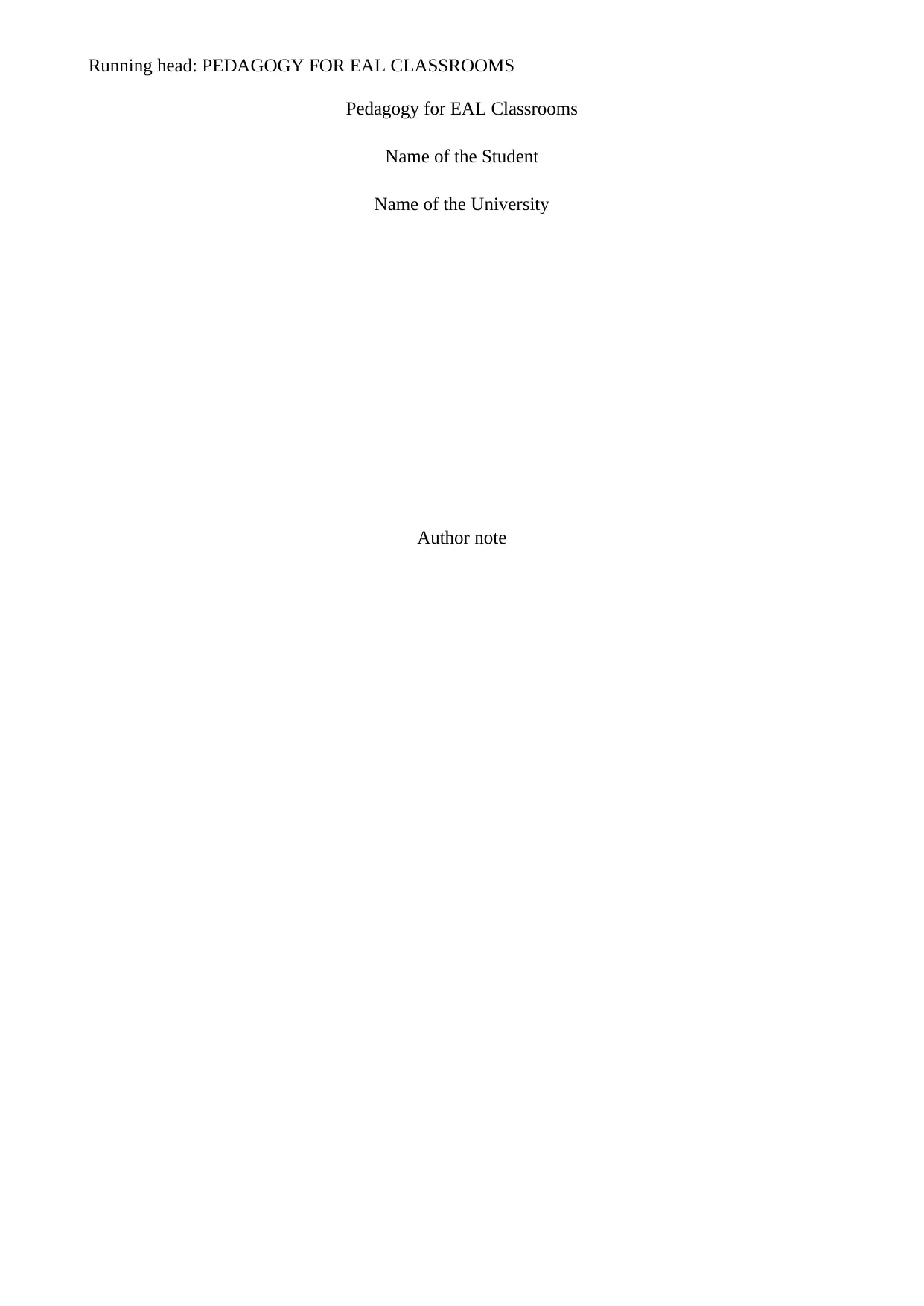
Running head: PEDAGOGY FOR EAL CLASSROOMS
Pedagogy for EAL Classrooms
Name of the Student
Name of the University
Author note
Pedagogy for EAL Classrooms
Name of the Student
Name of the University
Author note
Paraphrase This Document
Need a fresh take? Get an instant paraphrase of this document with our AI Paraphraser

1PEDAGOGY FOR EAL CLASSROOMS
Part 1: Representation of teaching context
In this EAL/D teaching context, the target students are chosen from the ESL level 5 where
the students are 10 years old. In this level, learning English is not enough challenging as the pre-
primary level learning. However, the basic knowledge on language and literature is based on this
part of education. The aim of this ESL level 5 is to educate the student about appropriate
grammatical use, sentence construction while enhancing their vocabulary knowledge and parts of
speech. The chosen group of ESL level 5 are the student of a school named X. X is a school of
primary and sender level education. However, the primary level infrastructure is strong enough to
support the students by various advanced and effective teaching policies and procedure.
Most of the students of X school are from on native English speaking background.
Therefore, teaching these students about English literature is not as simple as the native English
speakers. In this age of 10 years, the children are less curious about any language and more curious
about the social and technical things around them (Baecher, 2012). Therefore, before teaching the
students about the English language as their Additional Language, they must understand the
importance of learning English at their age. Before participating in this learning session all students
must have, some essential eligibility that will help them to make them aligned with the learning
procedure (Foote et al., 2016). Knowing the English alphabet, word and sentence making is
essential for this learning session. All the student must have the basing understanding of the letters
and their pronunciation styles.
In this learning procedure, the students will be taught in a systematic educating system
where they have to participant in a curriculum based activity to make the language more easy,
interesting and simple for them (Farrell, 2014). The objective of the Lesson plan is to monitor the
improvement of the students while developing appropriate suggestion for them and to increase their
interest in English Language and speaking pattern. Before stating the lesson plan, it is obvious to
ensure that all students have the basing understanding of the letters and their pronunciation styles.
1
Part 1: Representation of teaching context
In this EAL/D teaching context, the target students are chosen from the ESL level 5 where
the students are 10 years old. In this level, learning English is not enough challenging as the pre-
primary level learning. However, the basic knowledge on language and literature is based on this
part of education. The aim of this ESL level 5 is to educate the student about appropriate
grammatical use, sentence construction while enhancing their vocabulary knowledge and parts of
speech. The chosen group of ESL level 5 are the student of a school named X. X is a school of
primary and sender level education. However, the primary level infrastructure is strong enough to
support the students by various advanced and effective teaching policies and procedure.
Most of the students of X school are from on native English speaking background.
Therefore, teaching these students about English literature is not as simple as the native English
speakers. In this age of 10 years, the children are less curious about any language and more curious
about the social and technical things around them (Baecher, 2012). Therefore, before teaching the
students about the English language as their Additional Language, they must understand the
importance of learning English at their age. Before participating in this learning session all students
must have, some essential eligibility that will help them to make them aligned with the learning
procedure (Foote et al., 2016). Knowing the English alphabet, word and sentence making is
essential for this learning session. All the student must have the basing understanding of the letters
and their pronunciation styles.
In this learning procedure, the students will be taught in a systematic educating system
where they have to participant in a curriculum based activity to make the language more easy,
interesting and simple for them (Farrell, 2014). The objective of the Lesson plan is to monitor the
improvement of the students while developing appropriate suggestion for them and to increase their
interest in English Language and speaking pattern. Before stating the lesson plan, it is obvious to
ensure that all students have the basing understanding of the letters and their pronunciation styles.
1

2PEDAGOGY FOR EAL CLASSROOMS
The focus of this lesson plan is to enable the students to understand the English language structure,
word distribution and pronunciation while enhancing their stock of words and vocabulary. In
planning the lesson context, the objectives and activities should be balanced between focusing on
the language content and the cultural or cognitive content of the lesson (Faez & Valeo, 2012).
The aim of this lesson plan is mainly on language formation and structural context.
The learning and lesson content is not only limited to the ultimate goal of this EAL/D aim.
Engaging learner in social situation is essential which can give set up the target language while
gaining access to the socio-cultural context of the language itself (Kong, 2009). The primary and
post primary level infrastructure of X school is strong enough to support the specific curriculum
based English learning planning with advanced and effective teaching policies and procedures.
2
The focus of this lesson plan is to enable the students to understand the English language structure,
word distribution and pronunciation while enhancing their stock of words and vocabulary. In
planning the lesson context, the objectives and activities should be balanced between focusing on
the language content and the cultural or cognitive content of the lesson (Faez & Valeo, 2012).
The aim of this lesson plan is mainly on language formation and structural context.
The learning and lesson content is not only limited to the ultimate goal of this EAL/D aim.
Engaging learner in social situation is essential which can give set up the target language while
gaining access to the socio-cultural context of the language itself (Kong, 2009). The primary and
post primary level infrastructure of X school is strong enough to support the specific curriculum
based English learning planning with advanced and effective teaching policies and procedures.
2
⊘ This is a preview!⊘
Do you want full access?
Subscribe today to unlock all pages.

Trusted by 1+ million students worldwide
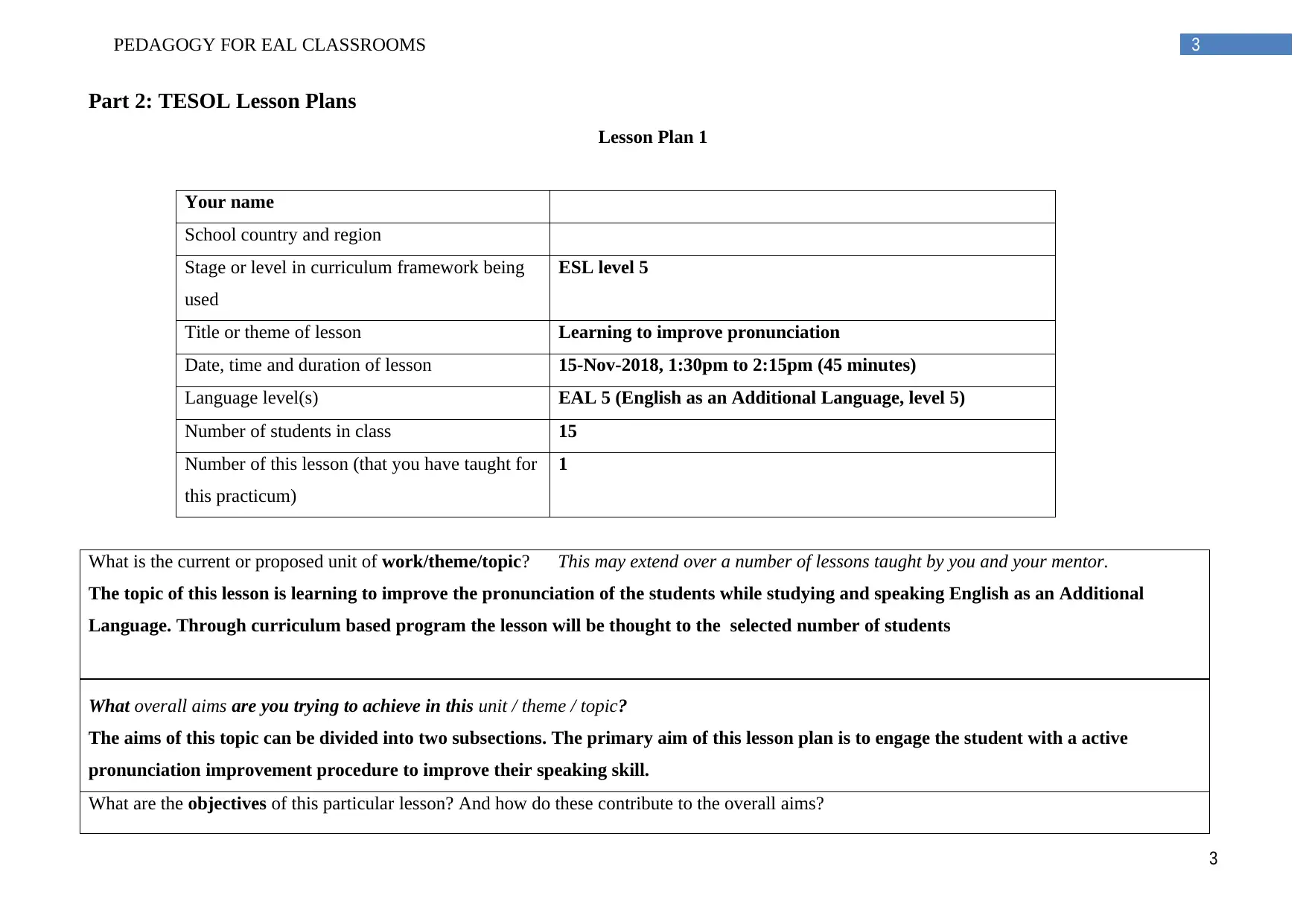
PEDAGOGY FOR EAL CLASSROOMS 3
Part 2: TESOL Lesson Plans
Lesson Plan 1
Your name
School country and region
Stage or level in curriculum framework being
used
ESL level 5
Title or theme of lesson Learning to improve pronunciation
Date, time and duration of lesson 15-Nov-2018, 1:30pm to 2:15pm (45 minutes)
Language level(s) EAL 5 (English as an Additional Language, level 5)
Number of students in class 15
Number of this lesson (that you have taught for
this practicum)
1
What is the current or proposed unit of work/theme/topic? This may extend over a number of lessons taught by you and your mentor.
The topic of this lesson is learning to improve the pronunciation of the students while studying and speaking English as an Additional
Language. Through curriculum based program the lesson will be thought to the selected number of students
What overall aims are you trying to achieve in this unit / theme / topic?
The aims of this topic can be divided into two subsections. The primary aim of this lesson plan is to engage the student with a active
pronunciation improvement procedure to improve their speaking skill.
What are the objectives of this particular lesson? And how do these contribute to the overall aims?
3
Part 2: TESOL Lesson Plans
Lesson Plan 1
Your name
School country and region
Stage or level in curriculum framework being
used
ESL level 5
Title or theme of lesson Learning to improve pronunciation
Date, time and duration of lesson 15-Nov-2018, 1:30pm to 2:15pm (45 minutes)
Language level(s) EAL 5 (English as an Additional Language, level 5)
Number of students in class 15
Number of this lesson (that you have taught for
this practicum)
1
What is the current or proposed unit of work/theme/topic? This may extend over a number of lessons taught by you and your mentor.
The topic of this lesson is learning to improve the pronunciation of the students while studying and speaking English as an Additional
Language. Through curriculum based program the lesson will be thought to the selected number of students
What overall aims are you trying to achieve in this unit / theme / topic?
The aims of this topic can be divided into two subsections. The primary aim of this lesson plan is to engage the student with a active
pronunciation improvement procedure to improve their speaking skill.
What are the objectives of this particular lesson? And how do these contribute to the overall aims?
3
Paraphrase This Document
Need a fresh take? Get an instant paraphrase of this document with our AI Paraphraser
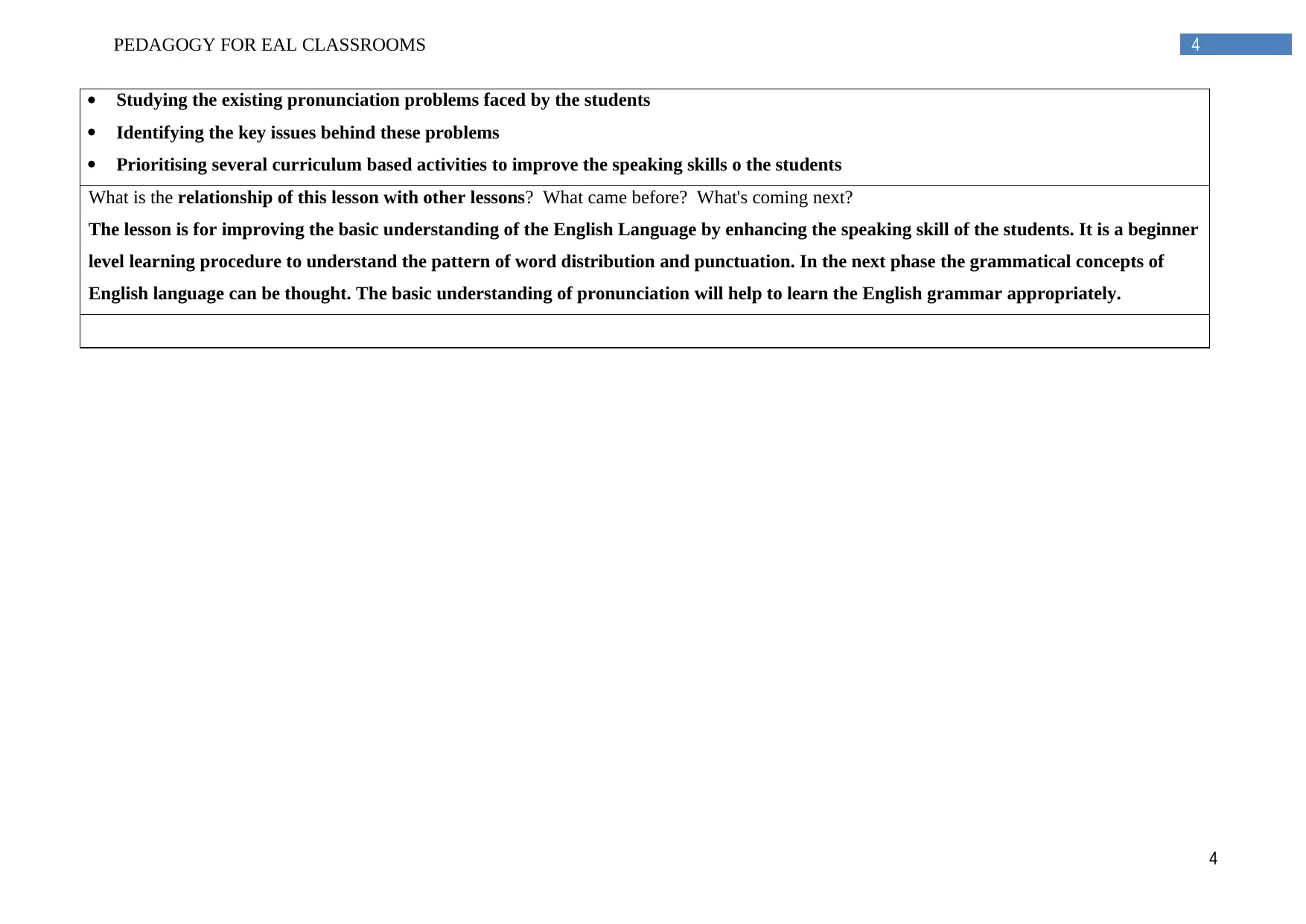
PEDAGOGY FOR EAL CLASSROOMS 4
Studying the existing pronunciation problems faced by the students
Identifying the key issues behind these problems
Prioritising several curriculum based activities to improve the speaking skills o the students
What is the relationship of this lesson with other lessons? What came before? What's coming next?
The lesson is for improving the basic understanding of the English Language by enhancing the speaking skill of the students. It is a beginner
level learning procedure to understand the pattern of word distribution and punctuation. In the next phase the grammatical concepts of
English language can be thought. The basic understanding of pronunciation will help to learn the English grammar appropriately.
4
Studying the existing pronunciation problems faced by the students
Identifying the key issues behind these problems
Prioritising several curriculum based activities to improve the speaking skills o the students
What is the relationship of this lesson with other lessons? What came before? What's coming next?
The lesson is for improving the basic understanding of the English Language by enhancing the speaking skill of the students. It is a beginner
level learning procedure to understand the pattern of word distribution and punctuation. In the next phase the grammatical concepts of
English language can be thought. The basic understanding of pronunciation will help to learn the English grammar appropriately.
4
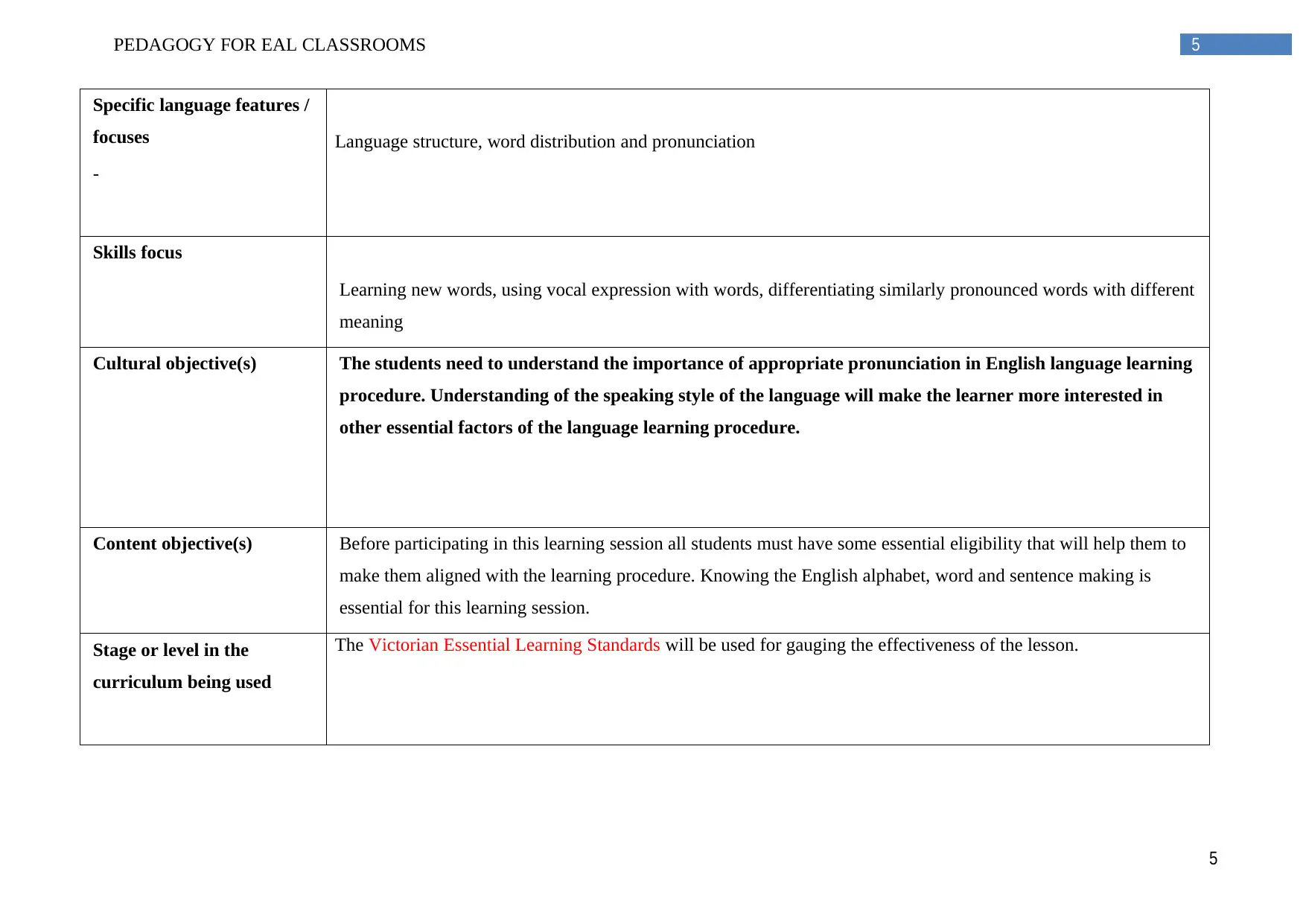
PEDAGOGY FOR EAL CLASSROOMS 5
Specific language features /
focuses
-
Language structure, word distribution and pronunciation
Skills focus
Learning new words, using vocal expression with words, differentiating similarly pronounced words with different
meaning
Cultural objective(s) The students need to understand the importance of appropriate pronunciation in English language learning
procedure. Understanding of the speaking style of the language will make the learner more interested in
other essential factors of the language learning procedure.
Content objective(s) Before participating in this learning session all students must have some essential eligibility that will help them to
make them aligned with the learning procedure. Knowing the English alphabet, word and sentence making is
essential for this learning session.
Stage or level in the
curriculum being used
The Victorian Essential Learning Standards will be used for gauging the effectiveness of the lesson.
5
Specific language features /
focuses
-
Language structure, word distribution and pronunciation
Skills focus
Learning new words, using vocal expression with words, differentiating similarly pronounced words with different
meaning
Cultural objective(s) The students need to understand the importance of appropriate pronunciation in English language learning
procedure. Understanding of the speaking style of the language will make the learner more interested in
other essential factors of the language learning procedure.
Content objective(s) Before participating in this learning session all students must have some essential eligibility that will help them to
make them aligned with the learning procedure. Knowing the English alphabet, word and sentence making is
essential for this learning session.
Stage or level in the
curriculum being used
The Victorian Essential Learning Standards will be used for gauging the effectiveness of the lesson.
5
⊘ This is a preview!⊘
Do you want full access?
Subscribe today to unlock all pages.

Trusted by 1+ million students worldwide
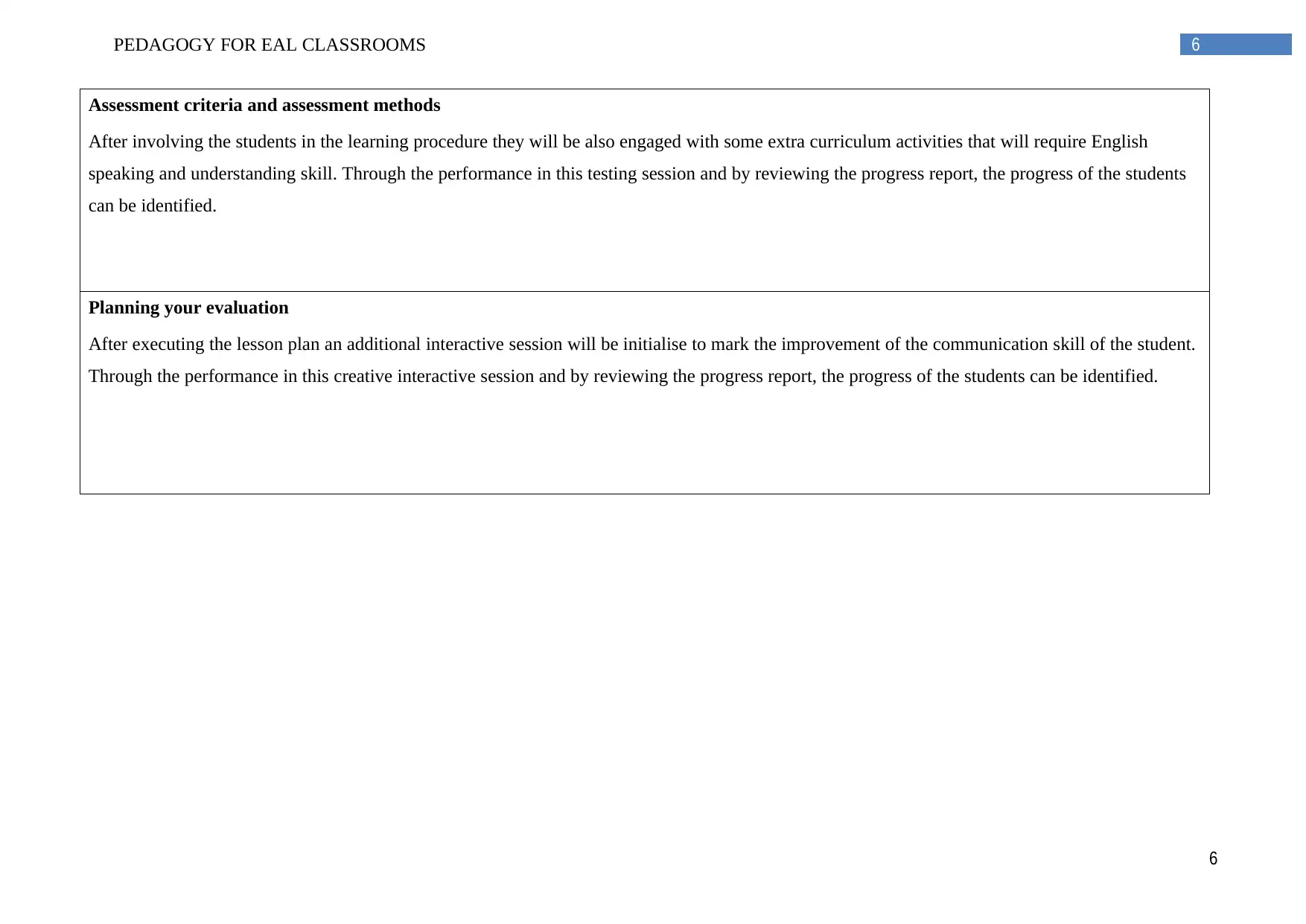
PEDAGOGY FOR EAL CLASSROOMS 6
Assessment criteria and assessment methods
After involving the students in the learning procedure they will be also engaged with some extra curriculum activities that will require English
speaking and understanding skill. Through the performance in this testing session and by reviewing the progress report, the progress of the students
can be identified.
Planning your evaluation
After executing the lesson plan an additional interactive session will be initialise to mark the improvement of the communication skill of the student.
Through the performance in this creative interactive session and by reviewing the progress report, the progress of the students can be identified.
6
Assessment criteria and assessment methods
After involving the students in the learning procedure they will be also engaged with some extra curriculum activities that will require English
speaking and understanding skill. Through the performance in this testing session and by reviewing the progress report, the progress of the students
can be identified.
Planning your evaluation
After executing the lesson plan an additional interactive session will be initialise to mark the improvement of the communication skill of the student.
Through the performance in this creative interactive session and by reviewing the progress report, the progress of the students can be identified.
6
Paraphrase This Document
Need a fresh take? Get an instant paraphrase of this document with our AI Paraphraser
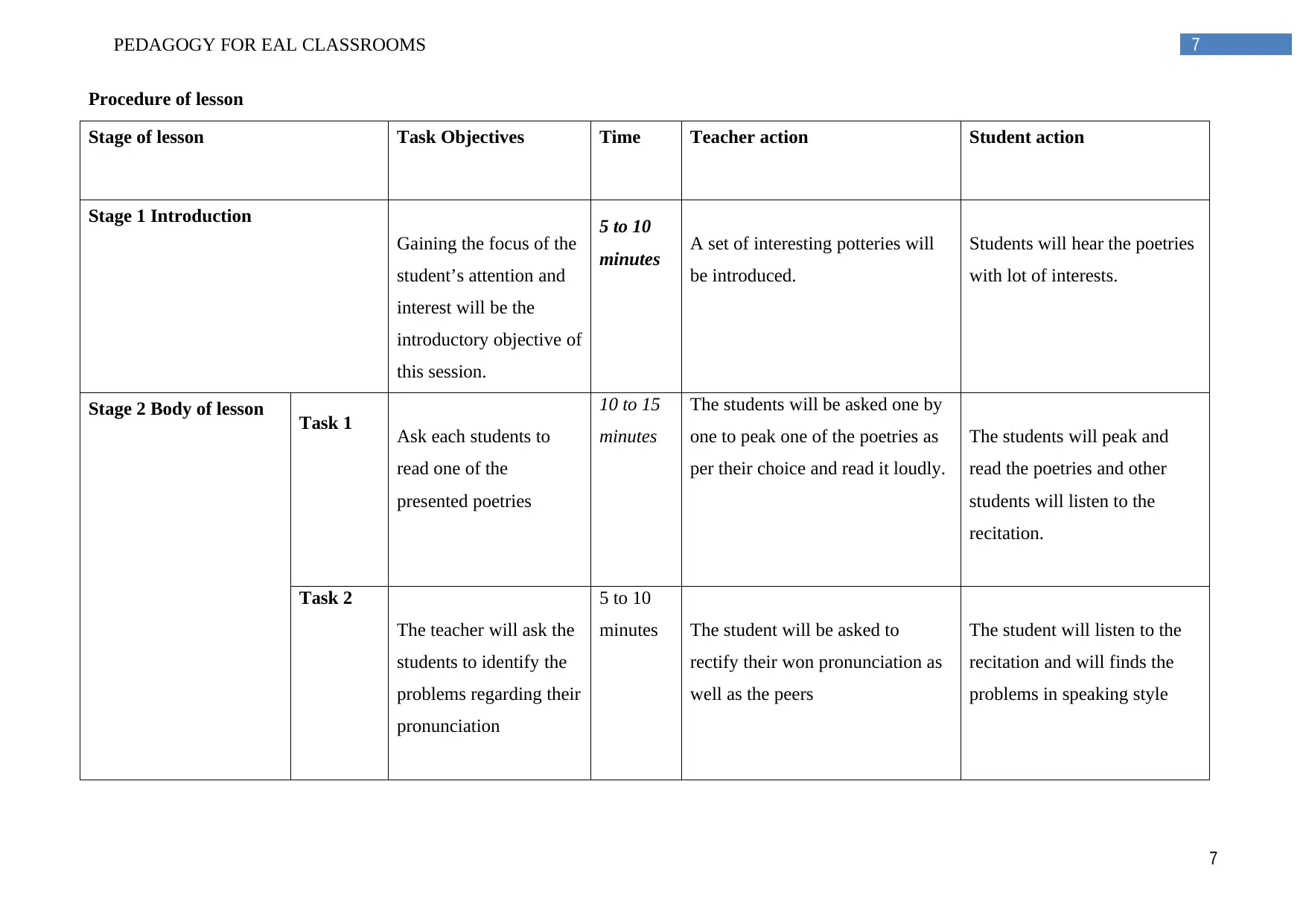
PEDAGOGY FOR EAL CLASSROOMS 7
Procedure of lesson
Stage of lesson Task Objectives Time Teacher action Student action
Stage 1 Introduction
Gaining the focus of the
student’s attention and
interest will be the
introductory objective of
this session.
5 to 10
minutes A set of interesting potteries will
be introduced.
Students will hear the poetries
with lot of interests.
Stage 2 Body of lesson Task 1 Ask each students to
read one of the
presented poetries
10 to 15
minutes
The students will be asked one by
one to peak one of the poetries as
per their choice and read it loudly.
The students will peak and
read the poetries and other
students will listen to the
recitation.
Task 2
The teacher will ask the
students to identify the
problems regarding their
pronunciation
5 to 10
minutes The student will be asked to
rectify their won pronunciation as
well as the peers
The student will listen to the
recitation and will finds the
problems in speaking style
7
Procedure of lesson
Stage of lesson Task Objectives Time Teacher action Student action
Stage 1 Introduction
Gaining the focus of the
student’s attention and
interest will be the
introductory objective of
this session.
5 to 10
minutes A set of interesting potteries will
be introduced.
Students will hear the poetries
with lot of interests.
Stage 2 Body of lesson Task 1 Ask each students to
read one of the
presented poetries
10 to 15
minutes
The students will be asked one by
one to peak one of the poetries as
per their choice and read it loudly.
The students will peak and
read the poetries and other
students will listen to the
recitation.
Task 2
The teacher will ask the
students to identify the
problems regarding their
pronunciation
5 to 10
minutes The student will be asked to
rectify their won pronunciation as
well as the peers
The student will listen to the
recitation and will finds the
problems in speaking style
7

PEDAGOGY FOR EAL CLASSROOMS 8
Stage of lesson Task Objectives Time Teacher action Student action
Task 3
Making the students
aware of their issues
5 to 10
minutes
Teacher will assess the
pronunciation issues and will
make the students correct
Student will try to imitate the
pronunciation style of the
teacher.
Task 4
Guiding them to learn
easily
5 to 10
minutes Teacher will show the
pronunciation techniques in more
simplistic and syllable configured
technique
Student will repeat the same
words with appropriate
syllables
Task 5 Involving them in
creative implementation
5 minutes Teacher will ask the students to
read a poem comprised with
complex pronunciations
Student will try to implement
what they have learn
Task 6
Stage 3: Conclusion Evaluate the learning
through repetition
After involving the students in the
learning procedure they will be
also in group discussion
The student will consult with
each other about the
pronunciation
8
Stage of lesson Task Objectives Time Teacher action Student action
Task 3
Making the students
aware of their issues
5 to 10
minutes
Teacher will assess the
pronunciation issues and will
make the students correct
Student will try to imitate the
pronunciation style of the
teacher.
Task 4
Guiding them to learn
easily
5 to 10
minutes Teacher will show the
pronunciation techniques in more
simplistic and syllable configured
technique
Student will repeat the same
words with appropriate
syllables
Task 5 Involving them in
creative implementation
5 minutes Teacher will ask the students to
read a poem comprised with
complex pronunciations
Student will try to implement
what they have learn
Task 6
Stage 3: Conclusion Evaluate the learning
through repetition
After involving the students in the
learning procedure they will be
also in group discussion
The student will consult with
each other about the
pronunciation
8
⊘ This is a preview!⊘
Do you want full access?
Subscribe today to unlock all pages.

Trusted by 1+ million students worldwide
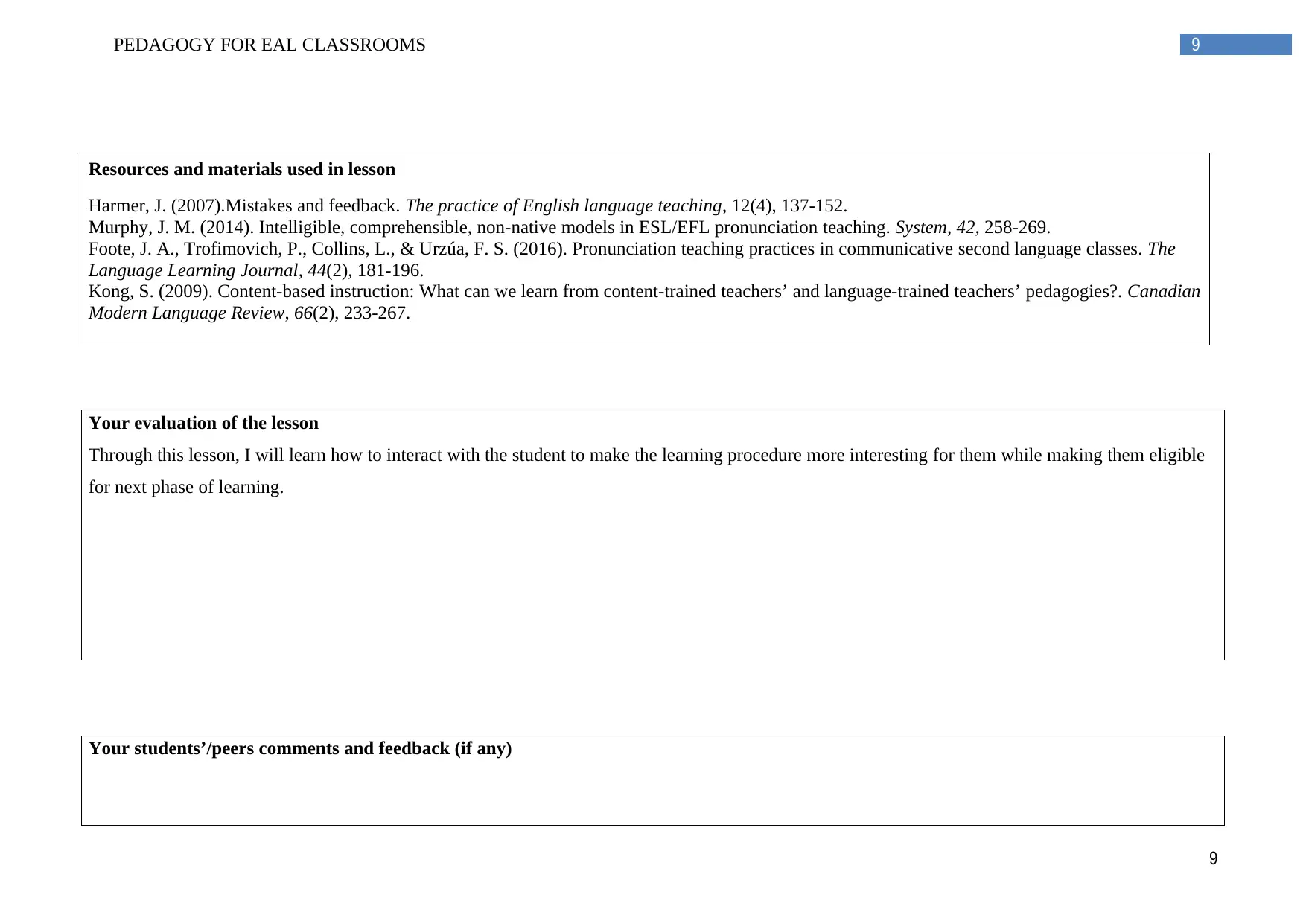
PEDAGOGY FOR EAL CLASSROOMS 9
Resources and materials used in lesson
Harmer, J. (2007).Mistakes and feedback. The practice of English language teaching, 12(4), 137-152.
Murphy, J. M. (2014). Intelligible, comprehensible, non-native models in ESL/EFL pronunciation teaching. System, 42, 258-269.
Foote, J. A., Trofimovich, P., Collins, L., & Urzúa, F. S. (2016). Pronunciation teaching practices in communicative second language classes. The
Language Learning Journal, 44(2), 181-196.
Kong, S. (2009). Content-based instruction: What can we learn from content-trained teachers’ and language-trained teachers’ pedagogies?. Canadian
Modern Language Review, 66(2), 233-267.
Your evaluation of the lesson
Through this lesson, I will learn how to interact with the student to make the learning procedure more interesting for them while making them eligible
for next phase of learning.
Your students’/peers comments and feedback (if any)
9
Resources and materials used in lesson
Harmer, J. (2007).Mistakes and feedback. The practice of English language teaching, 12(4), 137-152.
Murphy, J. M. (2014). Intelligible, comprehensible, non-native models in ESL/EFL pronunciation teaching. System, 42, 258-269.
Foote, J. A., Trofimovich, P., Collins, L., & Urzúa, F. S. (2016). Pronunciation teaching practices in communicative second language classes. The
Language Learning Journal, 44(2), 181-196.
Kong, S. (2009). Content-based instruction: What can we learn from content-trained teachers’ and language-trained teachers’ pedagogies?. Canadian
Modern Language Review, 66(2), 233-267.
Your evaluation of the lesson
Through this lesson, I will learn how to interact with the student to make the learning procedure more interesting for them while making them eligible
for next phase of learning.
Your students’/peers comments and feedback (if any)
9
Paraphrase This Document
Need a fresh take? Get an instant paraphrase of this document with our AI Paraphraser
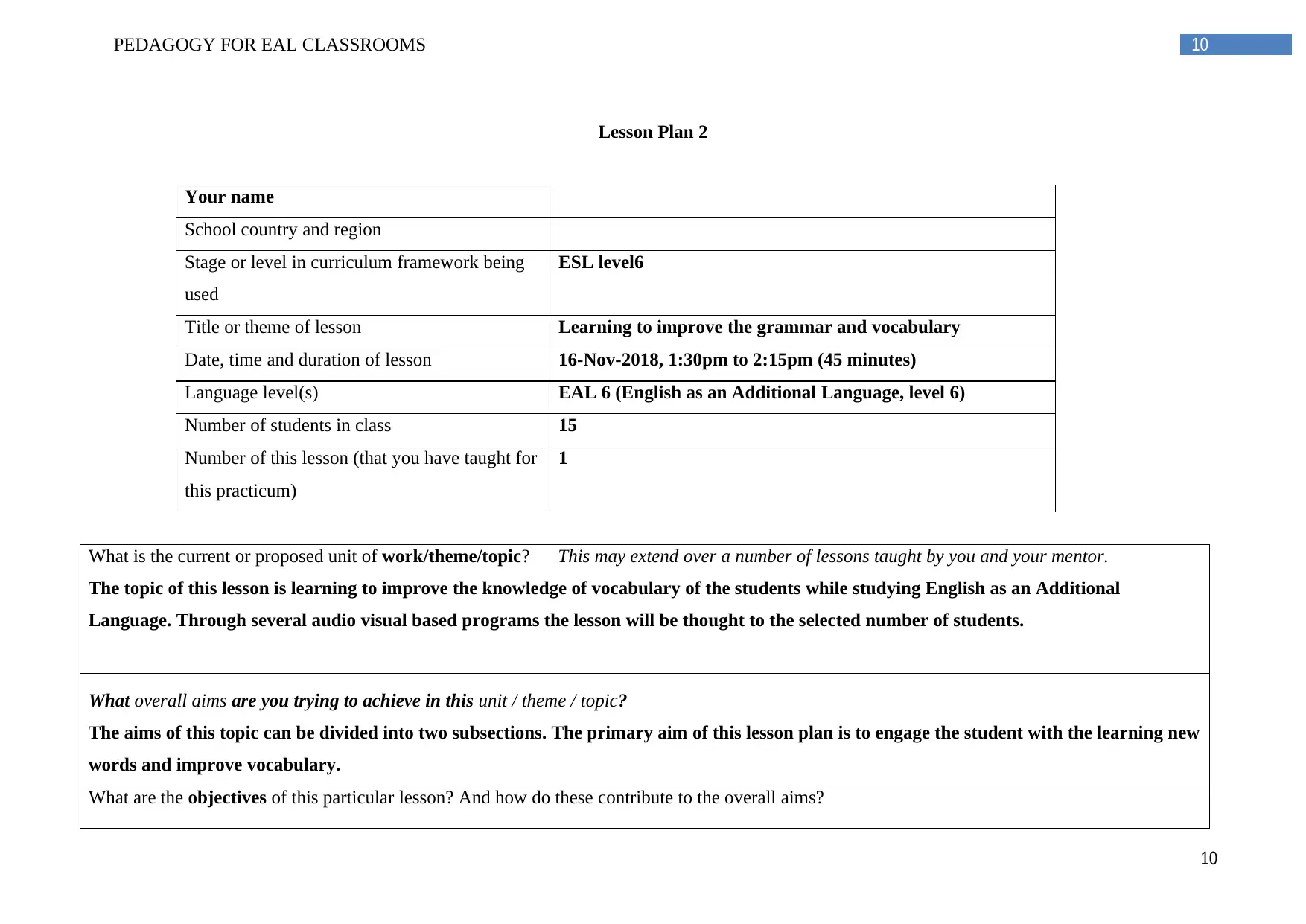
PEDAGOGY FOR EAL CLASSROOMS 10
Lesson Plan 2
Your name
School country and region
Stage or level in curriculum framework being
used
ESL level6
Title or theme of lesson Learning to improve the grammar and vocabulary
Date, time and duration of lesson 16-Nov-2018, 1:30pm to 2:15pm (45 minutes)
Language level(s) EAL 6 (English as an Additional Language, level 6)
Number of students in class 15
Number of this lesson (that you have taught for
this practicum)
1
What is the current or proposed unit of work/theme/topic? This may extend over a number of lessons taught by you and your mentor.
The topic of this lesson is learning to improve the knowledge of vocabulary of the students while studying English as an Additional
Language. Through several audio visual based programs the lesson will be thought to the selected number of students.
What overall aims are you trying to achieve in this unit / theme / topic?
The aims of this topic can be divided into two subsections. The primary aim of this lesson plan is to engage the student with the learning new
words and improve vocabulary.
What are the objectives of this particular lesson? And how do these contribute to the overall aims?
10
Lesson Plan 2
Your name
School country and region
Stage or level in curriculum framework being
used
ESL level6
Title or theme of lesson Learning to improve the grammar and vocabulary
Date, time and duration of lesson 16-Nov-2018, 1:30pm to 2:15pm (45 minutes)
Language level(s) EAL 6 (English as an Additional Language, level 6)
Number of students in class 15
Number of this lesson (that you have taught for
this practicum)
1
What is the current or proposed unit of work/theme/topic? This may extend over a number of lessons taught by you and your mentor.
The topic of this lesson is learning to improve the knowledge of vocabulary of the students while studying English as an Additional
Language. Through several audio visual based programs the lesson will be thought to the selected number of students.
What overall aims are you trying to achieve in this unit / theme / topic?
The aims of this topic can be divided into two subsections. The primary aim of this lesson plan is to engage the student with the learning new
words and improve vocabulary.
What are the objectives of this particular lesson? And how do these contribute to the overall aims?
10
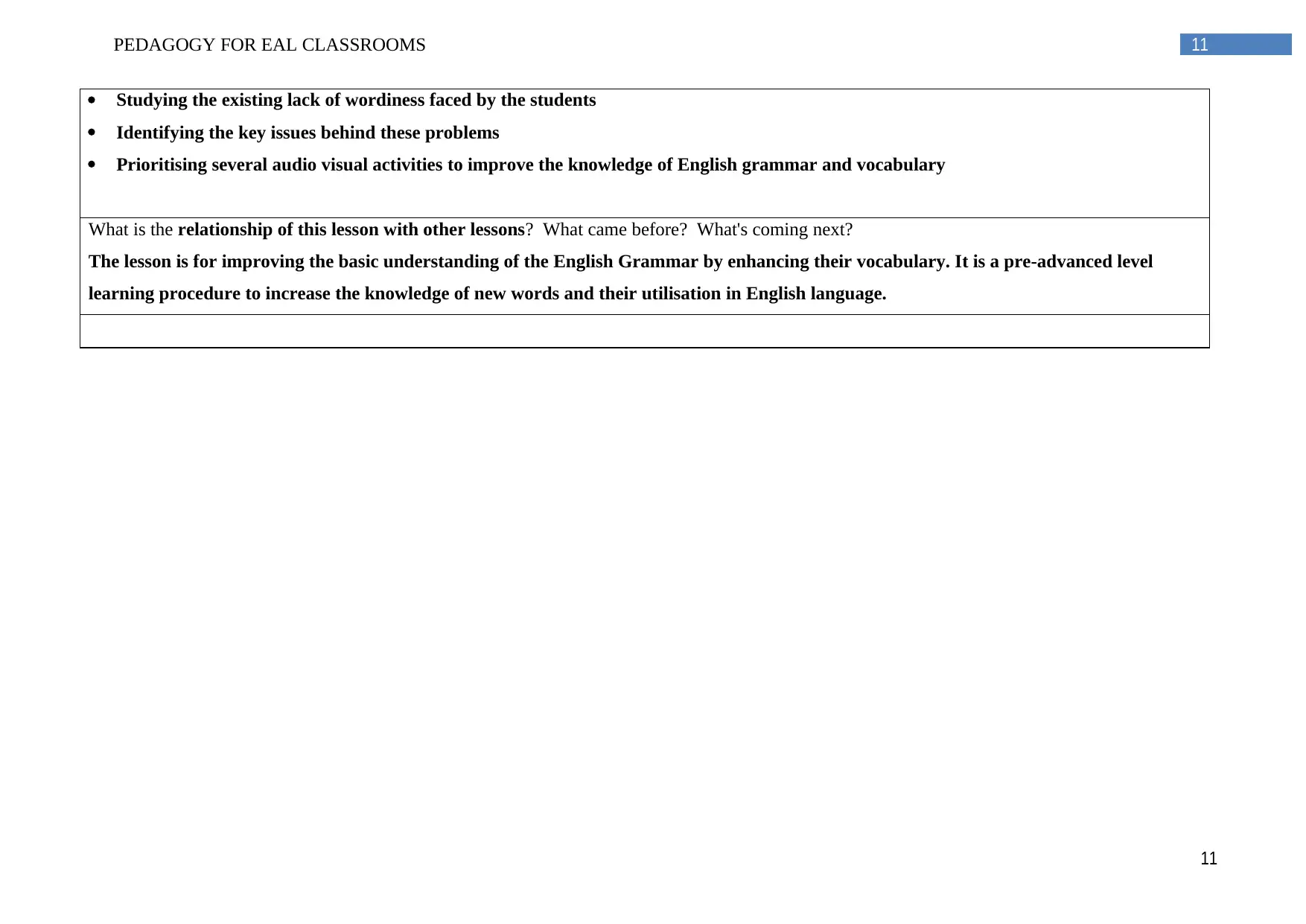
PEDAGOGY FOR EAL CLASSROOMS 11
Studying the existing lack of wordiness faced by the students
Identifying the key issues behind these problems
Prioritising several audio visual activities to improve the knowledge of English grammar and vocabulary
What is the relationship of this lesson with other lessons? What came before? What's coming next?
The lesson is for improving the basic understanding of the English Grammar by enhancing their vocabulary. It is a pre-advanced level
learning procedure to increase the knowledge of new words and their utilisation in English language.
11
Studying the existing lack of wordiness faced by the students
Identifying the key issues behind these problems
Prioritising several audio visual activities to improve the knowledge of English grammar and vocabulary
What is the relationship of this lesson with other lessons? What came before? What's coming next?
The lesson is for improving the basic understanding of the English Grammar by enhancing their vocabulary. It is a pre-advanced level
learning procedure to increase the knowledge of new words and their utilisation in English language.
11
⊘ This is a preview!⊘
Do you want full access?
Subscribe today to unlock all pages.

Trusted by 1+ million students worldwide
1 out of 21